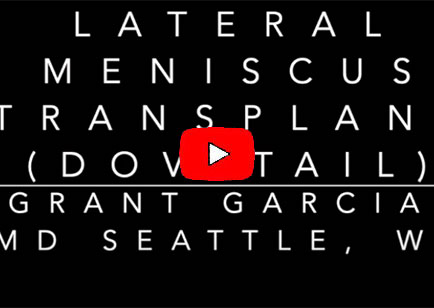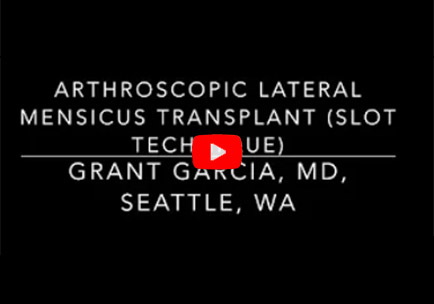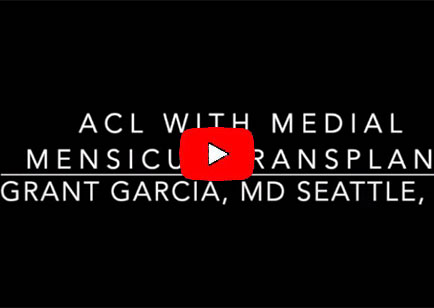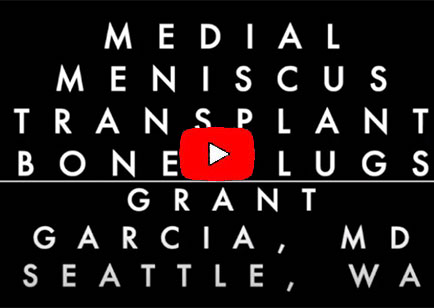Meniscus Transplant Surgery: Advanced Joint Preservation for Active Patients
-
Dr. Garcia’s lecture on meniscus and cartilage transplants
-
Meniscal Transplantation
Introduction and Background
The meniscus is one of the most important structures inside the knee. Each knee has two menisci - one on the inside (medial) and one on the outside (lateral). These C-shaped wedges of fibrocartilage act like shock absorbers, cushioning the joint, distributing weight across the cartilage, and providing stability. They also play a vital role in proprioception (the knee’s ability to sense movement and position), which is critical for athletic performance.
Unfortunately, meniscus tissue has a limited blood supply, especially in its central portion. This means many meniscus tears do not heal well after injury. For decades, the most common treatment for irreparable tears was partial meniscectomy, where the torn tissue is removed. While this can reduce pain in the short term, we now know that removing too much meniscus dramatically increases the risk of early arthritis. Without its protective buffer, the knee cartilage is exposed to increased forces, accelerating joint wear.
For patients who have already lost their meniscus and developed ongoing pain, meniscus transplantation has emerged as a powerful joint preservation strategy. This procedure involves replacing the missing meniscus with a donor allograft, carefully matched in size and shape to the patient’s knee. The goal is to restore normal biomechanics, reduce pain, and delay the progression of arthritis.
Lonzo Ball returns to the 2024 NBA season after cartilage surgery.
Who Is a Candidate? Indications and Patient Selection
Not every patient with knee pain is a candidate for a meniscus transplant. Careful evaluation is essential to identify those most likely to benefit.
Ideal candidates include:
- Younger, active patients (typically under age 50) who have persistent pain after a prior meniscectomy.
- Meniscal deficiency documented by imaging or surgical history.
- Mild to moderate cartilage changes but no advanced arthritis.
- Stable knees with good alignment (or patients willing to undergo additional procedures, such as ACL reconstruction or osteotomy, to correct instability or malalignment).
- Motivated individuals willing to commit to a structured rehabilitation program.
Contraindications include:
- Advanced osteoarthritis.
- Uncontrolled inflammatory conditions (such as rheumatoid arthritis).
- Significant obesity.
- Active infection.
- Patients unwilling to modify activity level or follow rehab restrictions.
Because the procedure is resource-intensive, patient selection remains the cornerstone of good outcomes. In properly chosen patients, meniscus transplantation can significantly reduce pain and restore function.
Cartilage and Meniscus Transplant and Surgical Options
Preoperative Evaluation
Before proceeding with surgery, patients undergo a comprehensive assessment:
- Detailed history and physical exam focusing on prior injuries, surgeries, instability, and mechanical symptoms.
- Imaging: X-rays to evaluate alignment and cartilage health; MRI to assess residual meniscus and cartilage condition.
- Gait and alignment analysis to determine if corrective osteotomy is necessary.
- Discussion of activity goals: patients must understand the realistic expectation of improved function and pain relief, not necessarily unlimited return to high-impact sports.
In many cases, meniscus transplantation is part of a multi-step strategy rather than a single intervention. For example, a patient with varus alignment, cartilage defects, and a prior meniscectomy may require a combined high tibial osteotomy, cartilage restoration, and meniscus transplant to achieve the best result.
Surgical Technique in Detail
Meniscus transplantation is one of the most technically demanding operations in sports medicine. Precision is critical, as even small mismatches in graft size or positioning can compromise long-term outcomes.
1. Graft Sizing and Preparation
Accurate graft sizing is the first step. Using imaging measurements, the donor graft is selected from a tissue bank. Allografts are screened rigorously for infection risk. Some grafts include bone plugs or a bone bridge that replicate the meniscal root attachments; others are prepared for suture-only fixation.
2. Recipient Site Preparation
The surgeon arthroscopically evaluates the knee, removing scar tissue and preparing the joint surfaces. Any residual meniscal tissue that might interfere with graft placement is trimmed. At this stage, associated procedures such as ACL reconstruction or cartilage restoration may also be performed.
3. Graft Implantation
Technique for combined ACL reconstruction with a medial meniscus transplant
There are two main categories of fixation:
- Bone plug or bone bridge fixation: The graft’s anterior and posterior horns are attached to small bone plugs that fit into tunnels drilled in the tibia, replicating natural attachment points.
- Suture-only fixation: The graft is stabilized with sutures passed through the capsule around the knee.
The graft is inserted into the joint through a mini-open incision or arthroscopically. Care is taken to orient it correctly, restore the joint contour, and avoid impingement.
4. Circumferential Fixation
Sutures are placed around the periphery of the graft to secure it to the capsule. This step ensures stability and allows the graft to heal into place. Surgeons often use advanced all-inside or inside-out techniques to accomplish this.
5. Final Testing
The knee is taken through its full range of motion to ensure the graft sits properly and moves naturally with the joint. The stability of fixation is confirmed before closing the incisions.
Modern refinements, including biologic augmentation (platelet-rich plasma, stem cells, or scaffolds), may be added to promote healing.
Outcomes and Long-Term Results
Research and clinical experience over the last 20 years have shown meniscus transplantation to be highly effective in appropriately selected patients.
- Pain Relief and Function: Most patients experience substantial reduction in pain and improvement in daily activities.
- Return to Activity: While not every patient returns to competitive pivoting sports, many return to recreational activities such as cycling, swimming, skiing, or light running.
- Delay of Arthritis: Studies show slower progression of joint degeneration compared to patients without meniscus. This can delay or prevent the need for knee replacement.
- Survivorship: Ten-year graft survival rates range between 70–90%, with many lasting 15 years or more.
Dr. Garcia’s updated technique for ACL with medialmeniscus transplant surgery
Patients should understand that the goal is joint preservation, not joint replacement. Meniscus transplantation is designed to protect the native knee for as long as possible, not to restore it to a “never injured” state.
-
Dr. Garcia demonstrates his technique for a lateral meniscus transplant using the dovetail technique

-
Step by step surgical video for a lateral meniscus transplant.

Rehabilitation After Meniscus Transplant
Recovery is a gradual process, requiring patience and commitment. Rehabilitation typically follows these phases:
Phase 1: Early Protection (Weeks 0–6)
- Crutches with partial weight-bearing.
- Knee brace to control motion.
- Passive and assisted range-of-motion exercises to avoid stiffness.
- No squatting, twisting, or impact.
Phase 2: Intermediate Rehab (Weeks 6–12)
- Gradual return to full weight-bearing.
- Stationary biking, pool therapy, and light strengthening.
- Controlled motion to protect the graft.
Phase 3: Strengthening and Functional Training (Months 3–6)
- Progressive resistance training.
- Core and hip strengthening.
- Functional balance and proprioceptive exercises.
Phase 4: Return to Sport (Months 6–12)
- Sport-specific drills only after surgeon clearance.
- Return to low-impact recreational sports is common; cutting/pivoting sports are evaluated case-by-case.
Close coordination between surgeon, physical therapist, and patient is critical to achieve optimal results.
Potential Complications
Even in experienced hands, complications can occur:
- Graft failure or non-healing: Persistent pain may require revision surgery.
- Stiffness: Aggressive scar tissue can limit motion if early rehab is neglected.
- Infection: Extremely rare but possible with any graft procedure.
- Neurovascular injury: Very uncommon but a risk with deep sutures.
- Progression of arthritis: In patients with more advanced disease, pain relief may be temporary.
Overall, complication rates are low, and the majority of patients report improvement compared to their pre-operative state.
Dr. Garcia demonstrates his cutting edge technique for medial meniscus transplantation
Meniscus Transplantation in the Context of Joint Preservation
Meniscus transplantation is rarely performed in isolation. It often forms part of a comprehensive joint preservation plan that may include:
- Cartilage restoration: Techniques such as autologous chondrocyte implantation (MACI), osteochondral grafts, or microfracture.
- Realignment surgery: High tibial osteotomy or distal femoral osteotomy to correct malalignment.
- Ligament reconstruction: Particularly ACL reconstruction, which stabilizes the knee and protects the transplant.
- Biologics: Injections or augmentation to promote healing and reduce inflammation.
The ultimate goal is to restore normal biomechanics and slow down the “wear and tear” process. This integrated approach is particularly powerful for young patients facing the prospect of early joint replacement.
Check out our recent testimonial after ACL, Meniscus and Cartilage Transplant
Frequently Asked Questions (FAQ)
How long does a meniscus transplant last?
Most grafts last 10–15 years, and many survive longer. The longevity depends on activity level, cartilage health, and surgical technique.
Can I return to sports?
Most patients return to low-impact recreational activities. High-level pivoting sports like basketball or soccer carry higher risk and may need to be limited.
Is donor tissue safe?
Yes. Allografts are rigorously screened, sterilized, and tested to ensure safety. The risk of disease transmission is extremely low.
Will I need another surgery later?
Some patients may require revision procedures, cartilage restoration, or eventual joint replacement. The goal is to delay or prevent those outcomes.
What if I already have arthritis?
Meniscus transplantation is less successful if arthritis is advanced. Patients with bone-on-bone arthritis are better served with partial or total knee replacement.
-
Check out our scope after medial meniscus transplant 1 year later, well healed and difficult to tell its a cadaver tissue.
-
Second look after lateral meniscus transplant
The Future of Meniscus Preservation
Advances in tissue engineering, 3D printing, and biologic augmentation may eventually allow us to create synthetic or bioengineered menisci tailored to each patient. Early trials with scaffolds and synthetic meniscus replacements are underway, but allograft transplantation remains the gold standard today.
Conclusion
Meniscus transplantation is a highly specialized, technically demanding surgery that has transformed the landscape of knee joint preservation. For young and active patients with meniscal deficiency, it provides pain relief, improved function, and a real opportunity to extend the life of their knee.
By combining careful patient selection, modern surgical techniques, and structured rehabilitation, meniscus transplantation allows patients to return to active lifestyles while delaying or avoiding the need for knee replacement. As part of the broader field of joint preservation, it represents a commitment to protecting the native knee and giving patients the chance to remain active for decades to come.
-
Check out our recent video testimonial after lateral meniscus transplant
-
Video testimonial after 3rd Time ACL Recon and Medial Meniscus Transplant
-
Video testimonial after meniscus transplant in an adolescent with a difficult knee issue
-
Revision ACL, Meniscus Transplant, Cartilage Transplant Testimonial
-
Lateral meniscus transplant with cartilage transplant
-
Video testimonial after a revision ACL, meniscus and cartilage transplant in a young athlete
-
Medial Meniscus Transplant Testimonial 2025




















